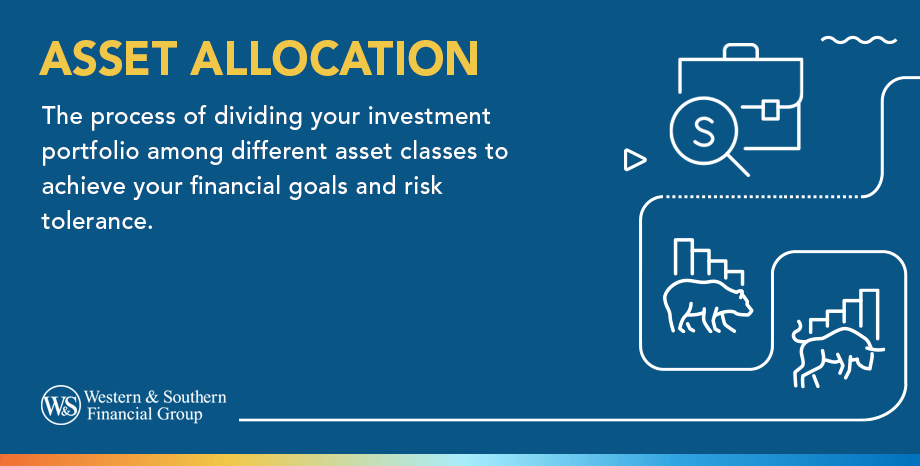Table of Contents
Table of Contents


Key Takeaways
- Asset allocation refers to the mix of investment assets like stocks, bonds, and cash in your portfolio.
- Your asset allocation depends on your time horizon and risk tolerance.
- Asset allocation is the foundation of diversification. First you determine your asset mix, then you pick specific investments within those assets.
- Asset allocation can have a bigger impact on your portfolio's returns than selecting individual investments.
- Asset allocation is important but you may want help from a financial professional to determine the right mix for your goals and risk tolerance.
Asset allocation is an important aspect of investment portfolio construction. This is because you need to determine your mix of investment assets — which may include stocks, bonds and cash — before you select specific investment securities.
Here's what you need to know about the basics of asset allocation and how it relates to diversification.
Defining Asset Allocation
Asset allocation refers to the mix of certain investment assets that are held in an investment portfolio, such as stocks, bonds, and cash.1 Determining how to allocate your mix of assets is one of the first steps in forming an investment objective, such as education savings or retirement. After deciding how to allocate the assets, you can then choose the specific investments.
Choosing Your Asset Allocation
Your asset allocation will depend on two primary factors: your holding period and your risk tolerance. These are based on your individual preferences, so keep in mind that your plan may not look like anyone else's. Before choosing your asset allocation, you'll need to measure and plan for the two factors:
- Holding period: This is the amount of time you plan to hold your investment assets. This period can also be defined as the amount of time before you begin to make withdrawals from your investments.
- Risk tolerance: This is measured by how much risk you are comfortable taking. For example, an individual with a low tolerance for risk may choose to allocate a relatively low amount of their portfolio — perhaps 50% or less — to stocks, which can have more volatile returns.
Before choosing an asset allocation, make sure to measure and plan for two factors: holding period and risk tolerance.
Asset Allocation & Stock Diversification
Asset allocation is also the foundation of diversification, which is the concept and strategy of spreading investments across a range of assets and investment types.2 The first step in diversification is determining your asset allocation (choosing the mix of asset types). The second step in diversification is choosing the individual investment types within those assets.
Here's an example of these two basic steps:
- Determine asset allocation: Let's say an investor chooses an asset allocation of 75% stocks, 20% bonds and 5% cash.
- Determine investment types: After choosing the asset allocation, the investor chooses investments within each asset type. For example, within the 75% stock allocation, the investor could create their stock diversification by selecting mutual funds in diverse categories, such as large-cap stocks, small-cap stocks and international stocks.
While having a good mix of assets can help to strengthen your portfolio, remember that diversification cannot guarantee profit or protection against loss in a declining market.
Why Asset Allocation Is Important
When building a portfolio of investments, an investor has control over asset allocation and investment selection. Between those two variables, asset allocation can have a greater impact on the total return of the portfolio, especially for long-term holding periods. In simple terms, your chosen mix of stocks, bonds and cash may have more of an impact on your portfolio returns than your selection of individual investments.
For example, an individual investing for retirement (which they plan to be 20 years from now) would likely expect an asset allocation of 85% stocks and 15% bonds (Portfolio A) to outperform an allocation of 65% stocks and 35% bonds (Portfolio B). This is because the historical returns for stocks are nearly double that of bonds. Just keep in mind that investments cannot guarantee growth or sustainment of principal value; they may also lose value over time. Past performance is not an indication of future results.
The Bottom Line
Although the portfolio construction process can be relatively easy, each individual investor has unique financial goals and tolerance for risk. For this reason, investors might want to seek the help of a financial professional to help guide them in asset allocation and investment selection.
Choose asset allocations that align with your investing goals. Invest In My Future
Sources
- Beginners’ Guide to Asset Allocation, Diversification, and Rebalancing. https://www.investor.gov/additional-resources/general-resources/publications-research/info-sheets/beginners-guide-asset.
- What is diversification? https://www.investor.gov/additional-resources/information/youth/teachers-classroom-resources/what-diversification.
























